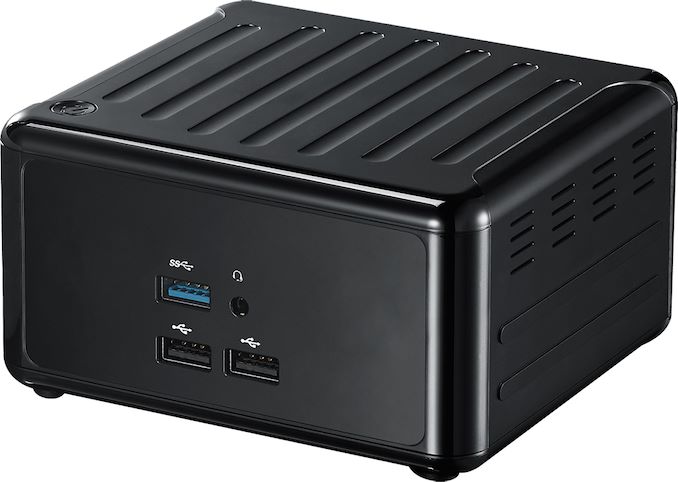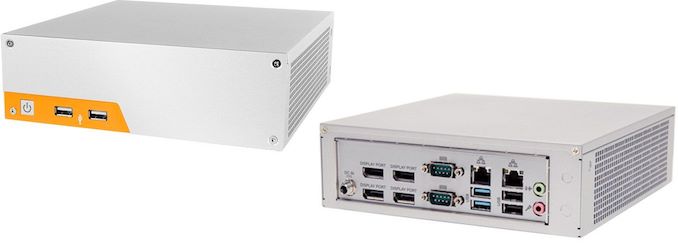Ryzen UCFF-palooza: Multiple PC Makers Now Shipping AMD Ryzen Embedded Systems
by Anton Shilov on December 4, 2019 5:00 PM EST- Posted in
- Desktop
- AMD
- UCFF
- Ryzen Embedded

While AMD's Ryzen Embedded APUs aren't new, the rate of adoption for them is. AMD unveiled this week that four more manufacturers are now offering ultra-compact form-factor (UCFF) PCs powered by their embedded Ryzen APUs. With systems shipping from ASRock, EEPD, OnLogic, and SimplyNUC, the small form factor boxes can be used for a wide variety of use cases, ranging from home entertainment to business and industrial applications.
ASRock’s 4X4 BOX R1000V UCFF PCs Finally Available
Originally introduced earlier this year, ASRock’s 4X4Box R1000V and 4x4 BOX-R1000M systems come in black Intel NUC-like chassis that packs a motherboard with soldered down AMD’s dual-core Ryzen Embedded R1505G APU with Radeon Vega 3 Graphics or dual-core Ryzen Embedded R1606G APU with Radeon Vega 3 Graphics, respectively.
The systems have everything that we come to expect from a modern PC, including two SO-DIMM slots supporting up to 32 GB of DDR4-2400 memory, an M.2-2260 slot for a SATA or PCIe 3.0 x4 SSD, two Realtek RTL8111G GbE controllers, Intel’s Wireless-AC 3168 module, multiple USB Type-A ports (three USB 3.0, two USB 2.0), three display outputs (two DisplayPorts, one HDMI), and a 3.5-mm audio jack.
AMD’s Ryzen Embedded R-series processors are rated to run for 24/7, so ASRock’s 4X4 Box-R1000M and 4X4 Box-R1000V can be used for applications that need to be always on, such as digital signage, kiosks, and so on. Meanwhile, three display outputs make ASRock's AMR Ryzen Embedded-based systems rather decent solutions for office. Finally, as the boxes include a watchdog timer and are rated to run at temperatures of up to 40ºC, the system can be used for non-extreme industrial applications.
ASRock’s 4X4 Box-R1000M and 4X4 Box-R1000V are now finally available as barebones. Prices of actual systems will depend on their configurations, whereas barebones are now sold at Newegg: the model R1000V costs $309.99, whereas the model V1000M is priced at $409.99.
EEPD’s ProFive NUCR with AMD R1000
EEPD offers ProFive NUCR single-board-computers (SBCs) powered by AMD’s dual-core Ryzen Embedded R1505G or 1606G APUs. The motherboards measure 101.6 mm × 101.6 mm and are designed primarily for industrial-grade embedded systems or custom NUC-like chassis.
EEPD’s ProFive NUCR with AMD’s Ryzen Embedded R1000-series APUs are rated to operate in temperature ranges between 0°C and + 60°C and with a maximum relative humidity of 95% @ 40°C (non-condensing), so they can indeede be used for a wide variety of applications. The SBCs have two SO-DIMM memory slots, three M.2 slots for SSDs or Wi-Fi modules (Type B, Type E, Type M), a SATA header, two GbE ports, two DisplayPort++ connectors, USB 3.1 Gen 1 connectors, a microSD slot, RS-232 and RS-232/485 ports, and GPIO.
The manufacturer says that in addition to embedded, commercial, and industrial applications, its ProFive NUCR with AMD’s Ryzen Embedded R1000-series APUs can be used for vehicles and mobile robots, which greatly expands use cases for the parts as these applications will see a serious growth in the coming years.
EEPD does not disclose pricing of its ProFive NUCR SBCs, but it is obvious that they depend on multiple factors, including volumes and additional options.
OnLogic’s MC510-40 AMD Ryzen Mini-ITX Computer
OnLogic uses one of AMD’s highest performing Ryzen Embedded APU model V1605B with four cores and Radeon Vega 8 graphics. The system is aimed at a range of applications, including those that need more general purpose and graphics horsepower, but may be used for embedded applications and even home entertainment too.
OnLogic’s MC510-40 AMD Ryzen Mini-ITX computer comes in a stylish aluminum + steel chassis that can pack up to 32 GB of DDR4 memory, an M.2-2280 SSD, and a 2.5-inch HDD or SSD. As for connectivity, the system has Wi-Fi or optional 4G support, two GbE ports, four DisplayPort 1.3 outputs, six USB connectors (four USB 3.1 and two USB 2.0), two RS-232 ports, and audio connectors. One of the things that differentiate the MC510-40 from competing Ryzen Embedded is support for an mPCIe socket for expansion.
The MC510-40 machine is certified to work in temperature ranges between 0°C and 50°C, which is wide enough for home/office, kiosks, commercial, and some industrial applications. Meanwhile, the APU requires active cooling, so potentially hot environments will not be suitable for this PC.
OnLogic currently offers its MC510-40 barebones for €656.95 w/o VAT (€794.91 w/ VAT), but when fully configured the system will naturally cost more.
SimplyNUC’s Sequoia UCFF PCs
SimplyNUC’s Sequoia UCFF PCs with AMD’s quad-core Ryzen Embedded APUs come in small rugged NUC-like chassis that can withstand up to 95% of relative humidity as well as temperatures as high as 60°C. The manufacturer says that the systems can be used for a wide range of applications, including edge data analytics, electronic kiosks, and digital signage.
Unlike its rivals, SimplyNUC offers pre-configured Sequoia UCFF systems. The cheaper one is the Sequoia v6 equipped with AMD’s quad-core Ryzen V1605B processor, 4 GB of memory, and a 128 GB SSD. The more advanced one is the Sequoia v8 is based on AMD’s quad-core Ryzen V1807B processor, 4 GB of DDR4 RAM, and 128 GB SSD. Meanwhile, SimplyNUC can further tailor its PCs for needs of a particular customer.
Since Sequoia systems will be used for a variety of applications, the maker equipped it with extensive connectivity, which includes Wi-Fi 5, Bluetooth 5, optional 4G/LTE modem, two GbE ports (controlled using Intel’s i210-LM), two Mini DisplayPort outputs, Serial RS-232/Serial RS-485 video outputs, an optional microSD card reader, and several USB 3.1 Gen 2 ports.
When shipped in default configurations, SimplyNUC’s Sequoia v6 is priced at £445, whereas the Sequoia v8 costs £560.
Related Reading:
- ASRock Reveals Mars UCFF PCs: 0.74-Liters With Intel Core Inside
- ASRock’s 4X4 Box-R1000: A Ryzen-Based 0.87-Liter SFF PC
- ASRock's Super Tiny DeskMini GTX Z390: Up to 9900K with MXM GPU
- Intel Confirms Comet Lake-Based NUC 10 ‘Frost Canyon’ UCFF PCs
- Intel’s Islay Canyon Mini NUCs Available: Whiskey Lake, Radeon 540X, 8GB LPDDR3
- Intel's Bean Canyon (NUC8i7BEH) Coffee Lake NUC Review - Ticking the Right Boxes
Source: AMD















24 Comments
View All Comments
Freeb!rd - Thursday, December 5, 2019 - link
What's wrong with "bare bones" one?https://www.newegg.com/p/N82E16856158064
This only uses AMD Ryzen Desktop APUs and no room for a GPU, but if you want that, then there are plenty of other AMD or Intel ITX options. I'm looking at one of these to replace an old AMD 5150 HTPC.
Spunjji - Friday, December 6, 2019 - link
Comes with the territory - you're paying for the always-on rating, dual-Ethernet, manageability etc. rather than just the raw specification.brucethemoose - Wednesday, December 4, 2019 - link
What's the deal with 12nm Ryzen APUs these days? First the Surface, then premium devices from other OEMs, and now all these embedded NUC-like boxes?It's like everyone missed the memo when the original 14nm chip came out, and for some reason they decided to catch up at a time when the platform is much less competitive.
benedict - Thursday, December 5, 2019 - link
AMD probably has plenty of those in storage and selling them to OEMs at fire sale price.deil - Thursday, December 5, 2019 - link
first series was a BIT more power hungry. Maybe now it ticks all the boxes and they just have no reason to ignore it anymore. AND there was something with AM4 board as there was literally NO mini-itx board since ryzen 1 up to 3.Spunjji - Friday, December 6, 2019 - link
There have been a fair few ITX boards for Ryzen from B350 upwards. Not an avalanche, for sure, but a lot more than literally none.GreenReaper - Thursday, December 5, 2019 - link
Yeah, not that many gonna want them when the Zen 2 ones come out - at least, not at this price. This is likely to be the last big sales opportunity for them at anything like a premium price.qlum - Thursday, December 5, 2019 - link
I am betting on supply being the main reason. there is probably stock to spare on the amd side where intel really strugglesThe_Assimilator - Thursday, December 5, 2019 - link
All of AMD's "Embedded Ryzen" chips are 14nm because they're based on the original Zen arch, not Zen+ or Zen 2. The slew of announcements is unsurprising considering Intel's continued inability to deliver enough CPUs to keep up with demand, therefore manufacturers are forced to turn to AMD's older CPUs instead. And I'll bet AMD has discounted their embedded CPUs too to make them irresistible to manufacturers who can't get Intel chips.msroadkill612 - Thursday, December 5, 2019 - link
Its madness folks. For god's sake, solve ur current problem w/ an intel IGP, or an amd apu that doesnt exist yet.